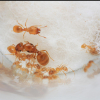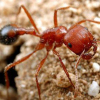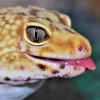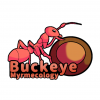2. Date of collection: 7/3/2020
3. Habitat of collection: Near a forest / open sandy field
4. Length (from head to gaster): 7 mm
5. Color, hue, pattern and texture: Shiny Black on all surfaces EXCEPT on the Petiole and on her side (which is a dark red)
6. Distinguishing characteristics: Petiole is red
7. Distinguishing behavior: None
8. Nest description: None
9. Nuptial flight time and date: Found late last night at around 11:25 P.M. (Temp. was 75 D. Fahrenheit, Humidity was 75%)
Yes, I realize that Crematogaster lineolata and Crematogaster cerasi are indistinguishable at this level, but I’ve never seen one with a red petiole, so I’m wondering if it’s a different species altogether? Here’s some pictures:





















 . I had just woken up when I typed that. Gosh dang I need to read titles
. I had just woken up when I typed that. Gosh dang I need to read titles



















